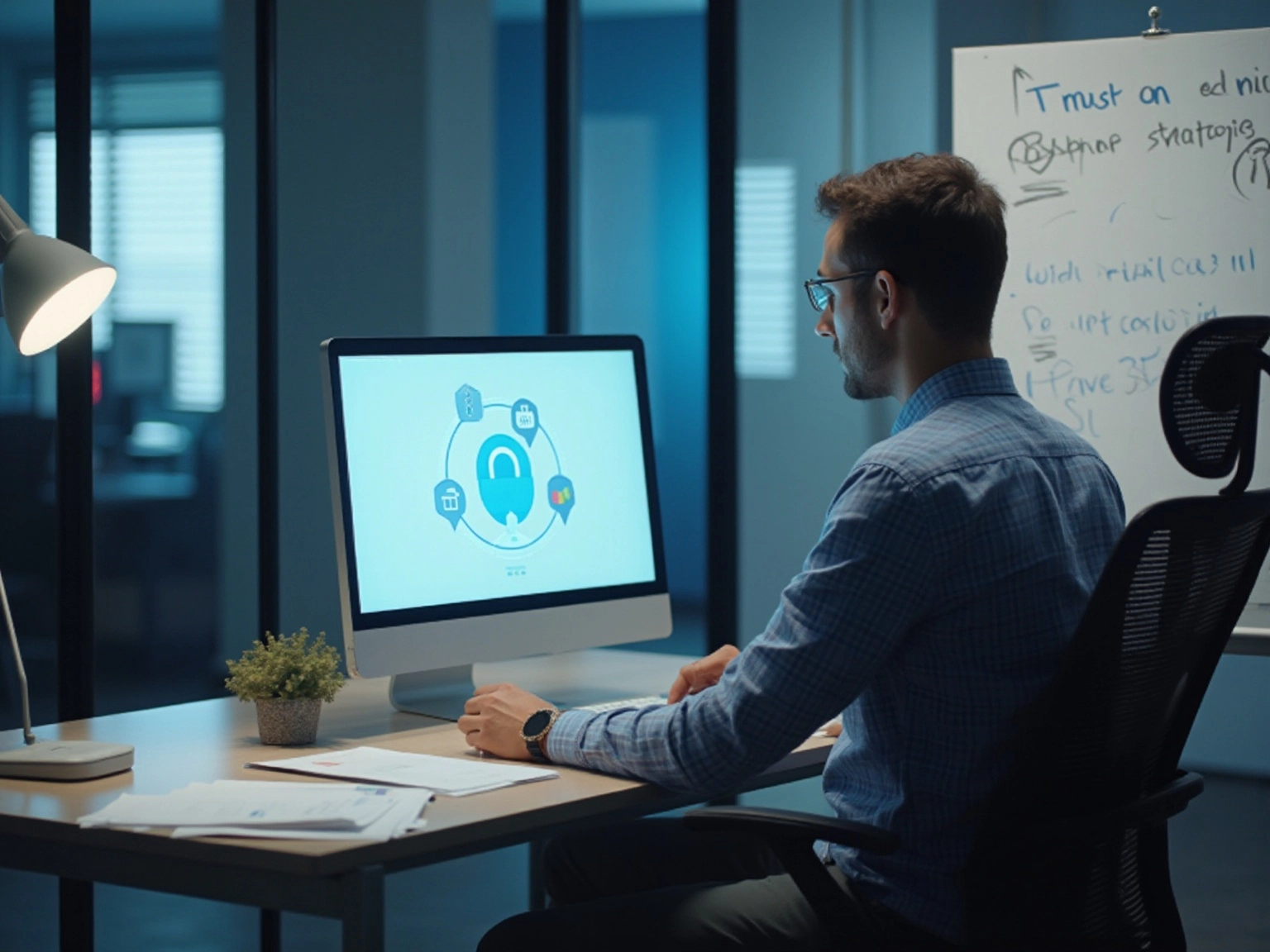Overview
The article underscores the critical importance of effectively sharing large files, particularly within the accounting sector. It highlights that security, efficiency, and the utilization of advanced file-sharing platforms are paramount. By adopting structured methods and secure tools—such as cloud storage and specialized transfer services—accounting professionals can significantly enhance productivity, reduce response times, and safeguard sensitive information. This is evidenced by real-world cases, such as TaxAssist Accountants, who saved an impressive 288 hours during a tax season through improved file-sharing practices.
Key Highlights:
- In 2025, efficient large file sharing is essential for businesses, especially in accounting, due to the exchange of high-resolution images and extensive datasets.
- Advanced file-sharing platforms can increase customer response rates by 40% and reduce response times by 50%, enhancing workflow efficiency and client satisfaction.
- The cybersecurity market is projected to reach $212 billion by 2025, highlighting the need for secure document transfer solutions to prevent costly data breaches.
- Companies like WeTransfer are leading by offsetting their carbon footprint, appealing to environmentally conscious accounting managers.
- TaxAssist Accountants saved 288 hours in one tax season by implementing streamlined file-sharing solutions, showcasing the tangible benefits of effective document transfer.
- Common methods for sharing large files include email, cloud storage services, transfer services, FTP/SFTP, and physical storage devices, each with distinct advantages.
- Email is limited to 20-25MB attachments, making cloud storage solutions like Google Drive and Dropbox more suitable for large files.
- Glasscubes offers a centralized platform for secure document sharing, enhancing communication and client engagement while minimizing email inefficiencies.
- Implementing secure practices, such as using encrypted services and password protection, is crucial for safeguarding sensitive information during file transfers.
- A structured approach to file sharing can significantly improve document turnaround time and enhance collaboration within accounting teams.
Introduction
In the digital landscape of 2025, the ability to share large files has become a cornerstone of operational efficiency, particularly within the accounting sector. As businesses increasingly rely on high-resolution images, extensive datasets, and detailed reports, the demand for effective file-sharing solutions has surged. This necessity not only facilitates seamless collaboration but also ensures the secure exchange of sensitive information, ultimately enhancing productivity and client satisfaction.
With statistics revealing significant time savings and improved client response rates, organizations are now prioritising innovative tools that streamline these processes. As cyber threats loom larger, understanding the landscape of file-sharing methods and their implications on security becomes vital for accounting firms aiming to maintain a competitive edge.
Understanding the Need for Large File Sharing
In the rapidly evolving digital landscape of 2025, the ability to share big files efficiently has become essential for businesses across various sectors, particularly in accounting. High-resolution images, extensive reports, and large datasets are frequently exchanged, necessitating solutions that allow for effective file sharing. This demand stems from the need for seamless collaboration on projects, secure transmission of sensitive information, and the timely exchange of multimedia content.
The impact of efficient document distribution on productivity in accounting is profound. With the right tools, accountants can significantly reduce the time spent on information retrieval and communication. For instance, firms that utilise advanced file-sharing platforms have reported a remarkable 40% increase in customer response rates and a 50% reduction in response times. These enhancements not only improve workflow efficiency but also lead to greater client satisfaction.
Statistics underscore the significance of large document transfers in the accounting sector. With the cybersecurity market projected to reach $212 billion by the end of 2025, the demand for secure document transfer solutions is increasingly critical. In an environment where data breaches can cost organisations billions—such as the education sector, which faced over $53 billion in downtime due to ransomware attacks—accounting firms must prioritise secure and efficient methods to share big files. This highlights the broader implications of secure document exchange, emphasising the financial consequences of data breaches on organisations.
Moreover, companies like WeTransfer are setting an example by offsetting 100% of their carbon footprint, aligning digital innovation with environmental stewardship. This approach may resonate with accounting managers who are increasingly focused on sustainability in their operations.
Real-world examples illustrate how businesses leverage file-sharing technologies to boost productivity. For instance, TaxAssist Accountants, through the implementation of streamlined file-sharing solutions, reported saving an impressive 288 hours in just one tax season. This case emphasises the tangible advantages of adopting efficient document transfer techniques that enable accountants to share big files and concentrate more on strategic activities rather than administrative follow-ups.
In conclusion, the importance of effective document exchange in the accounting sector in 2025 is clear. It facilitates timely access to critical information and enhances overall operational efficiency. As firms navigate the complexities of digital communication, investing in reliable file-sharing solutions—such as Glasscubes, which offers automated reminders and real-time reporting—will be paramount for maintaining a competitive edge and ensuring client satisfaction.
Exploring Different Methods for Sharing Large Files
When it comes to sharing large files, a multitude of methods are available, each presenting unique advantages and disadvantages. Here’s a closer look at some of the most effective options in 2025:
-
Email: While email remains a popular choice due to its convenience, it typically imposes strict size limits of 20-25MB. For larger documents, integrating email with cloud storage solutions can be advantageous, enabling users to share large files by sending links instead of attachments, thus avoiding size restrictions. However, email can lead to inefficiencies in communication, such as multiple threads and lost responses, which can be particularly challenging for accounting teams managing client data.
-
Cloud Storage Services: Platforms such as Google Drive, Dropbox, and OneDrive have become essential tools for sharing documents. These services enable users to upload files and share large files through links, effectively bypassing email limitations. The advantages of cloud storage include enhanced accessibility, collaboration features, and the capability to share large files securely while managing significant volumes of data. Organisations that leverage cloud storage are better positioned to handle the projected global data volume of 181 zettabytes by 2025, driven by advancements in AI and IoT. This is particularly relevant for accountants who need to manage extensive client data efficiently.
-
For accounting teams looking to streamline their workflows, Glasscubes offers an effortless onboarding experience with customised setup and support. During a quick initial call, the team configures the system to meet your specific needs, ensuring that your group can navigate the platform with ease. After this introductory call, most teams can expertly navigate the portal. Glasscubes tackles the issues of email by offering a centralised platform that allows users to share large files, along with secure document sharing, automated reminders, and real-time tracking of requests. This includes a visual progress report that allows teams to see outstanding requests clearly, enhancing client engagement and eliminating the inefficiencies associated with traditional email communication.
-
Transfer Services: Services like WeTransfer and Smash provide user-friendly solutions for sending large documents without the need for an account. These platforms are especially beneficial for quick transfers, enabling users to share large files up to 2GB for free, making them perfect for accountants needing to send documents swiftly. As noted by Sophie Montgomery from TaxAssist Accountants, using efficient tools can lead to significant time savings, with reports of 288 hours saved in just one tax season.
-
FTP/SFTP: For those with technical expertise, File Transfer Protocol (FTP) and Secure FTP (SFTP) provide robust solutions to share large files securely over the internet. These methods are particularly useful for organisations that require a high level of security and control over their data transfers, especially in light of the increase in cyber threats—attacks on financial websites in Australia increased by over 200% in 2022.
-
Physical Storage Devices: In instances where data is exceptionally large or sensitive, utilising physical storage devices such as USB drives or external hard drives can be an effective method. This approach guarantees safe management of data, especially when you need to share large files that contain sensitive information which may not be appropriate for online distribution.
As the environment of document exchange continues to develop, comprehending the advantages and disadvantages of each technique is vital for accountants aiming to enhance their workflows. The quickest possible high-speed data transfer can achieve up to 100 Gbps under optimal conditions, primarily utilising fibre-optic connections, which can greatly improve the efficiency of sharing. With the rise in cyber threats, choosing secure and efficient file-sharing methods, such as those offered by Glasscubes, is more important than ever.
Navigating File Size Limits and Email Challenges
Sharing large documents via email presents significant challenges that can hinder productivity and compromise security. Most email providers impose strict attachment size limits, typically ranging from 20MB to 25MB, with Outlook capping at 150MB. These limitations often lead to bounced emails or the frustrating necessity to compress documents, which may degrade their quality.
Moreover, email lacks robust security features, rendering it an unsuitable choice for transmitting sensitive information. A substantial percentage of businesses express concerns about the safety of sharing large files via email, highlighting the urgent need for more secure alternatives.
Prior to utilising such platforms, many accounting teams experienced considerable frustrations with email communication. They often relied on extensive email exchanges to request information from clients, resulting in lost data and repeated requests. This inefficiency not only complicated the audit process but also made tracking received information difficult.
Glasscubes revolutionises this process by providing a streamlined platform for client information requests, minimizing the chaos of email trails and enhancing communication.
To effectively navigate these challenges, consider implementing the following strategies:
- Utilise Cloud Services: Instead of attaching documents directly, upload them to a secure cloud service like Glasscubes and share the link. This method not only allows users to share large files without size restrictions but also enhances security through encryption.
- Compress Documents: Use compression tools such as WinZip or 7-Zip to reduce document size before sending. While this can assist with smaller documents, be cautious as excessive compression may impact document integrity.
- Split Documents: For exceptionally large files, consider dividing them into smaller segments and sending them separately. This approach can help manage size constraints while ensuring that the recipient receives all necessary components.
Real-world examples underscore the effectiveness of these strategies. Companies that have embraced innovative tools have reported a 40% increase in client response rates and a 50% reduction in response times, demonstrating how improved workflows can alleviate the challenges of traditional email document distribution. Additionally, users like Sophie Montgomery from TaxAssist Accountants have noted saving an impressive 288 hours in just one tax season by utilising the platform. The user-friendly interface and dedicated onboarding assistance, which includes a customised setup and support for accounting teams, further enhance its appeal. During the initial onboarding call, our team learns about your team composition and workflows, configuring the system to meet your needs. This ensures that accounting teams can expertly navigate the portal after just a brief introduction. By leveraging these strategies, businesses can significantly enhance their ability to share large files efficiently while ensuring security.

Top Tools and Platforms for Large File Transfers
When it comes to platforms that can effectively share big files, several stand out for their efficiency and user-friendly features. However, for accountants, Glasscubes emerges as a particularly effective tool that transforms customer engagement and streamlines communication. Here are some of the top tools for 2025:
-
Google Drive: With 15GB of free storage, Google Drive is a go-to for many accountants. It enables users to share documents via links, facilitating seamless collaboration and real-time updates, which is crucial for managing client materials efficiently.
-
Dropbox: Renowned for its intuitive interface, Dropbox enables sharing of up to 250GB. Its customisable permissions make it an excellent choice for accountants who need to control access to sensitive financial documents.
-
WeTransfer: This straightforward service allows users to send documents up to 2GB for free without requiring an account. Its simplicity makes it a popular choice for quick transfers, especially for accountants needing to send documents on the fly.
-
Smash: Providing the capability to transmit documents up to 50GB for free, Smash does not require registration, making it a hassle-free option for accountants who prioritise speed and ease of use.
-
Filemail: Recognised for its secure transfers, Filemail imposes no size limits, making it ideal for sending large documents such as comprehensive financial reports or customer presentations.
-
Hightail: This platform focuses on creative collaboration, enabling users to share big files while offering tracking features. This is especially advantageous for accountants engaged in projects that necessitate input and adjustments from customers.
Alongside these tools, the platform distinguishes itself in the accounting field by offering a secure, GDPR-compliant environment that has resulted in a 50% decrease in response times for communications with customers. Users like Steve, an audit manager at MGI, have reported significant improvements in engagement, noting that individuals appreciate the transparency of having all information in one place. The platform not only provides automated reminders and real-time tracking but also includes a visual progress report that enables accountants to see outstanding requests clearly. This organised approach ensures that no requests are overlooked, enhancing communication efficiency. Furthermore, with dedicated onboarding assistance, accounting firms can streamline processes and enhance interactions effectively. As firms increasingly adopt these tools, the emphasis on secure, efficient, and user-friendly platforms like Glasscubes becomes paramount, ensuring that accountants can manage their workflows effectively while enhancing client engagement.

Step-by-Step Guide to Sharing Large Files Effectively
To share large files effectively, particularly within accounting workflows, implement the following best practices:
-
Select the Right Method: Assess whether to utilise email, cloud storage, or a dedicated transfer service based on document size and recipient preferences. Each method offers distinct advantages, with cloud storage frequently delivering superior security and accessibility for large files. Our company offers a secure document transfer platform that streamlines this process, ensuring your data is protected while remaining readily accessible.
-
Organise Your Documents: Prior to sharing, confirm that your documents are well-organised and clearly named. This practice not only facilitates easy identification but also enhances professionalism in your communications. With Glasscubes, you can customise your document organisation to align with your team’s workflows, simplifying material management.
-
Upload or Attach: For cloud storage, upload your documents and generate a shareable link. If you choose email, attach the file directly or use a file transfer service that accommodates larger files. This platform simplifies the process, enabling quick uploads and effortless sharing of large files.
-
Set Permissions Wisely: When utilising cloud storage, configure appropriate permissions for the recipient, such as view or edit access, to maintain control over your documents. Glasscubes provides robust permission settings to ensure that sensitive information is shared securely.
-
Distribute the Link or Document: Share the generated link via email or send the document directly. Include any necessary instructions for accessing the documents to guarantee a smooth experience for the recipient. With this platform, you can automate reminders to enhance client engagement and ensure timely responses.
-
Confirm Receipt: After sending, follow up with the recipient to verify they received the documents and can access them without issues. This step is vital for maintaining effective communication and ensuring your documents are reviewed promptly. The platform offers tracking features that notify you when documents are accessed.
By implementing these strategies, you can significantly enhance your document turnaround time, facilitating quicker sharing of large files and potentially boosting close rates by over 28%. As organisations increasingly prioritise cloud security—with 32% of U.K. companies employing a data protection officer and many investing over half a million pounds for GDPR compliance—adopting a structured approach to file sharing not only mitigates risks but also fosters collaboration and efficiency in your accounting practices.
To ensure a seamless onboarding experience, the company provides a 30-minute introductory call during which our team assesses your specific requirements and tailors the system accordingly. This guarantees that you can navigate the platform effortlessly. As Mark Fairlie, a Senior Analyst, states, “Your document management software should be intuitive, budget-friendly, secure, and collaborative.”
Glasscubes exemplifies these qualities, ensuring both functionality and security for organisations managing sensitive data.
Discover how we transform customer engagements in just 4 minutes! Watch our on-demand demo to see how we streamline information gathering and improve client response times by 40%. Where should we send the link?
Submit to schedule a personalised demo with one of our Product Specialists.

Ensuring Security When Sharing Large Files
When transmitting large documents, particularly those containing confidential information, prioritising security is paramount. Implementing robust practices significantly mitigates risks associated with data breaches and unauthorised access. Here are key strategies to ensure secure sharing of documents:
- Utilise Encrypted Services: Select sharing platforms that provide end-to-end encryption, safeguarding your data during transit. In 2025, the emphasis on encryption is underscored by the fact that the average data breach costs around $3.65 million, highlighting the financial implications of inadequate security measures. Additionally, the alarming statistic that the Real Estate Wealth Network leaked 1.5 billion records in December 2023 illustrates the scale of data breaches that can occur.
- Implement Password Protection: Enhance security by setting passwords for shared documents, ensuring that only permitted users can access sensitive information. This approach lowers the risk of unauthorised access.
- Restrict Access: Share large files exclusively with individuals who require them for their work. Regularly review access permissions to confirm that only necessary personnel have access to sensitive data.
- Monitor Activity: Opt for platforms that offer tracking features, allowing you to observe who accesses your documents and when large files are shared. This transparency helps identify any unauthorised attempts to access sensitive information.
- Educate Recipients: Inform recipients about secure practices, such as avoiding the distribution of links or passwords with unauthorised individuals when sharing large files. This proactive approach can significantly enhance the overall security of shared files.
In light of recent statistics, such as the alarming increase in data breaches and the financial repercussions they entail, adopting these best practices is not just advisable but essential for accounting firms. Jacob Fox, an SEO manager, observed that the number of pentest engagements in the U.S. and U.K. rose by 31% in 2023, highlighting an increasing awareness of the necessity for secure document sharing practices. Moreover, utilising solutions such as Glasscubes’ secure document request portals can simplify the collection process, enabling users to share large files directly through secure links without the inconvenience of logging in. The portals offer automatic status updates and a clear checklist of necessary documents, enhancing user engagement and ensuring that sensitive documents are shared efficiently and securely. By prioritising secure document exchange, firms can safeguard their sensitive information and uphold client trust while conserving valuable time that can be better utilised on accounting tasks.

Key Takeaways for Successful Large File Sharing
Mastering the art of sharing large files is essential for success in today’s digital landscape, requiring a strategic approach that addresses both technical and collaborative aspects of transfer. Here are key takeaways to consider in 2025:
- Select the Appropriate Method: Tailor your document-sharing method to the size of the items and the preferences of your recipients. Choices vary from cloud storage solutions to specialised transfer services designed for sharing large files, each offering distinct benefits.
- Leverage Cloud Storage: Utilise cloud storage platforms to share large files, allowing you to bypass traditional email limitations and enabling seamless transmission of substantial documents without size restrictions.
- Emphasise Security: Prioritise the security of your transferred items by selecting encrypted services and implementing access controls. This is crucial in an era where the cybersecurity market is projected to reach $212 billion by the end of 2025, underscoring the increasing importance of data protection, especially when organisations need to share large files.
- Adopt a Structured Approach: Implement a systematic method for file sharing to enhance both efficiency and effectiveness. This structured approach streamlines the process while fostering better collaboration among team members. Organisations are increasingly adopting automation to enhance their data privacy practices, addressing the challenges posed by evolving regulations and the growing volume of consumer data. This not only improves the ability to share large files but also leads to enhanced collaboration and productivity within your professional environment. Real-world examples demonstrate that organisations employing effective file-sharing strategies have seen marked improvements in teamwork and project outcomes. For instance, Sophie Montgomery of TaxAssist Accountants reported an impressive 288 hours saved in just one tax season, reinforcing the value of these practices. Furthermore, investments in data privacy technologies are yielding significant returns, with organisations reporting increased customer loyalty and trust as a result of their privacy efforts.

Conclusion
The significance of effective large file sharing in the accounting sector is undeniable in 2025. As businesses navigate the complexities of digital communication, the right tools not only enhance operational efficiency but also secure the exchange of sensitive information. From cloud storage solutions like Google Drive and Dropbox to dedicated platforms like Glasscubes, accountants have a wealth of options to streamline their workflows and improve client engagement.
Prioritising security in file sharing is paramount, especially given the escalating risks associated with data breaches. Implementing strategies such as:
- End-to-end encryption
- Password protection
- Monitoring file activity
can significantly mitigate potential threats. By fostering a culture of security awareness among team members and clients, accounting firms can safeguard their sensitive data while maintaining trust.
Ultimately, adopting a structured and strategic approach to file sharing can lead to remarkable improvements in productivity and client satisfaction. Real-world examples highlight the tangible benefits, such as the impressive time savings reported by firms utilising innovative file-sharing solutions. As the landscape of file sharing continues to evolve, investing in reliable and secure platforms will be essential for accounting firms aiming to maintain a competitive edge in an increasingly digital world.
